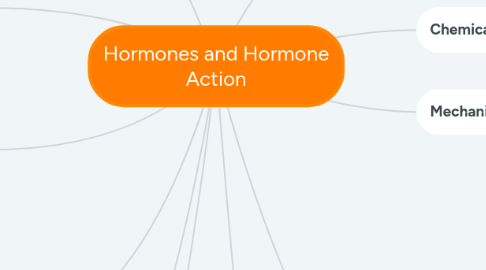
1. Regulation
1.1. Neurocrine: neuron hormones released near another cells
1.2. Paracrine: secretion effects adjacent cells
1.2.1. Islet of Langerhans: clustered cells in pancreas that produce hormones to regulate glucose
1.3. Autocrine: hormone has direct effect upon the cell that secreted it
2. Growth factors
2.1. Binds to plasma membrane receptors
2.2. Must be present in extracellular fluid
2.3. Cytokines: secreted by white blood cells (activates phagocytic cells)
3. Classes of Hormones
3.1. 1. Protein & peptides: inc. insulin (released by pituitary gland; regulates gonads)
3.2. 2. Amines: derived from amino acids
3.3. 3. Steroid: lipid hormones (derived from cholesterol, gonads and adrenal cortex)
4. Feedback Loops
4.1. 1. Receptor detects a change in stimulus and signals control centre 2. Control centre directs an effector mechanism to respond to signal to reverse the change
4.2. Connects response to stimulus
4.3. Negative: prevents excessive fluctuations (operates in endocrine and nervous)
4.4. Positive: reinforces stimulus (e.g. milk of mother)
5. Receptors
5.1. Specific receptor binds signal molecule
5.2. Usually located in plasma membrane of target cell (depends on lipid permeability)
5.3. Signal transduction: results in cell function change
6. Hormones not entering cells
6.1. Large/polar molecules (can't permeate plasma membrane)
6.2. 'second messenger' (indirectly modifies activity of protein kinases)
7. Homeostasis
7.1. Nervous System
7.2. Endocrine System
8. Chemical Messengers
8.1. Endocrine cells (hormone secreting cells)
8.2. Exocrine glands (releases secretions into a duct)
9. Mechanisms of Hormone Action
9.1. 1. Reception (receive)
9.1.1. 2. Signal transduction (cell signalling)
9.1.1.1. Response (reply)
10. Sites of synthesis
10.1. Hypothalamus
10.1.1. Endocrine fuctions
10.1.2. Initiates endocrine signals
10.2. Posterior pituitary
10.2.1. Regulates pituitary gland activity
10.2.2. Secretes oxytocin and ADH
10.2.2.1. ADH increases water reabsorption
10.2.2.2. Oxytocin helps uterine contractions and milk ejections
10.3. Anterior pituitary
10.3.1. stimulates hormones from other glands
10.4. Thyroid glands
10.4.1. Located on ventral trachea
10.4.2. Secretes T3 and T4
10.4.3. Regulates cellular metabolism
10.5. Parathyroid glands
10.5.1. Controls plasma calcium levels
10.6. Endocrine pancreas
10.6.1. Comprises 1-2% pancreatic mass
10.6.2. Secretes insulin and glucagon
10.7. Adrenal glands
10.7.1. Secretes adrenalins by adrenal medulla
10.7.2. 'flight-or-fight' response
10.7.3. Also secretes sex hormones
10.8. Gonads
10.8.1. Sex hormones
10.8.1.1. Androgen (male
10.8.1.2. Estrogen (female)
10.8.1.3. Progestins
10.9. Pineal
10.9.1. Secretes melatonin
10.9.1.1. Controls sensory activity
10.9.1.2. Light-dark cycles (biological rhythms)

